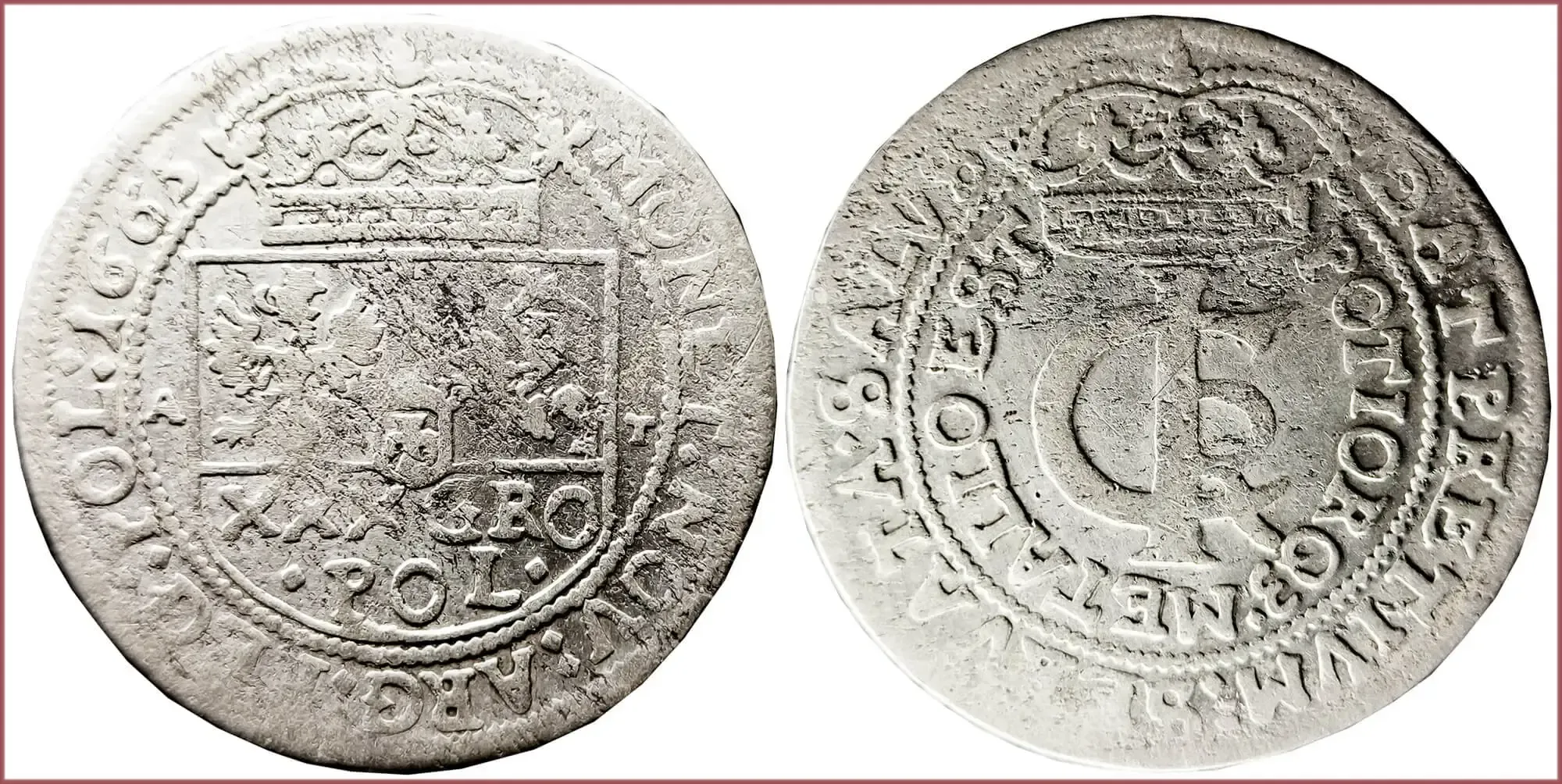TYMF: COIN OF POLISH-LITHUANIAN COMMONWEALTH
Tymf, 1665: Polish-Lithuanian Commonwealth
Ruler: John II Casimir Vasa (Polish "Jan II Kazimierz Waza") — King of Poland and Grand Duke of Lithuania (1648-1668), titular King of Sweden (1648-1660).
MONET NOV ARG REG POL - 1665 (Moneta Nova Argentum Regnum Poloniae): new silver currency (coin) of the Kingdom of Poland - 1665.
XXX GRO POL: 30 groszy of Poland.
AT sign on the sides of the heraldic shield (Andrzej Tymf — tenant of a number of Polish mints, who received the right to mint coins for the entire Kingdom).
Part of the coat of arms of the Polish-Lithuanian Commonwealth with the coat of arms of the House of Vasa (in the center).
DAT PRETIVM SERVATA SALVS POTIOR QE METALLO EST: The desire to save the Fatherland exceeds the price of metal.
Crowned monogram of King John II Casimir (ICR — IOANNES CASIMIRUS REX).
Bydgoszcz Mint (Poland).
- Silver (0.500): 31 mm - 6.25 g
- Reference price: 20$
COIN TYMF — WHERE & WHEN (coins catalog: by names & emitents)
- POLISH-LITHUANIAN COMMONWEALTH (1663-1666): tymf = 30 groszy
TYMF as coin name.
Tymf — low-quality rather large billon coin of the Polish-Lithuanian Commonwealth (diameter: about 30 mm, weight: more than 6.5 g, 50% pure silver).
Along with copper boratynka and billon solid (szeląg), it was issued during 1663-1666 as credit money. Nominal value — 30, but in fact — only 12-15 groszy; it was sometimes equated to an ort (18 groszy).
At the beginning of the minting of the coin, it was considered a zloty (from the end of the 15th century, the unit of account of 30 groszy had exactly this name — zloty). Over time, the tymf was equated to the ort (18 groszy), but due to the too low silver content, the coin depreciated even more significantly.
It is interesting that tymf among numismatists, although more than 10 million of them were released, are most often found in extremely poor condition (low metal quality, long period of active use...).
A characteristic feature of the coin: the inscription in Latin "DAT PRETIVM SERVATA SALVS POTIORQ METALLO EST" ("The desire to save the Fatherland exceeds the price of metal") and the monogram of the King John II Casimir Vasa — "ICR" (IOANNES CASIMIRUS REX). The letter "R" in the monogram is often smaller than "C". Only on coins minted in Lviv (modern Ukraine) — on the contrary.
In a broader sense, tymf is sometimes also called other Polish coins with a denomination of 18 zlotych, issued after 1666 (in particular, in the 18th century), as well as similar in parameters of the contemporary coins of Prussia and, even, of the Russian Empire (for territories occupied during the Great Northern War and the Seven Years' War).
The name of the coin tymf (it is also spelled "tynf", "tympf"), although it is not displayed on the coin (the denomination is indicated as "XXX Gro Pol" — "30 Polish groszy"), it was widely used already during its circulation.
Why then "tymf"? — Everything is simple: the fact is that in the second half of the 17th century Polish Royal Mints were managed (and even leased) by Andrzej Tymf (German "Andreas Timpe"). In a difficult time for the Polish-Lithuanian Commonwealth, he became the author of the idea of issuing credit money — coins, on which the nominal value was higher than the real value of the metal (silver) used to mint the coin. Very quickly, the name tymf was attached to these low-quality coins. In monetary circulation, they confidently replaced full-fledged silver coins that settled "on the hands". Inflation has begun, the economy is in disarray...
By the way, the proverb "A good joke is worth tymf" has been preserved in Poland to this day.
In numismatic catalogs, this coin is also called złotówka koronna.











